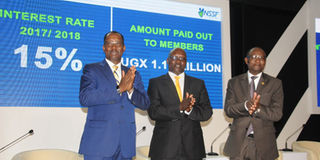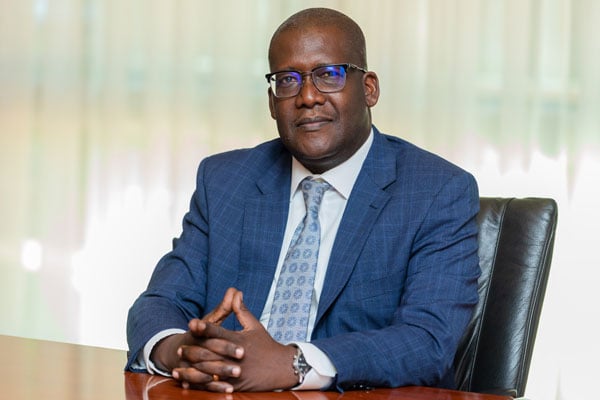How one NSSF amendment could change beneficiaries’ finances

From left to right, Mr Richard Byarugaba, NSSF managing director, State minister of finance for General duties, Mr Gabriel Ajedra and Mr Patrick Byabakama, NSSF Board chairperson announce the 15 per cent interest rate on members’ contributions during the Annual Members’ Meeting in August. NSSF is the only compulsory saving scheme where employees contribute 5 per cent and employers, 10 per cent. Photo BY ERONIE KAMUKAMA
What you need to know:
NSSF is relying on the changes in the law to allow employees access money earlier among other things, Eronie Kamukama writes.
At this year’s annual members’ meeting, Mr Wills Tumwine, a management consultant, passionately spoke against the current benefits structure at National Social Security Fund (NSSF) despite the fact that the members received 15 per cent interest on their savings this year. He pointed out that the Fund’s structure presents a bar to growth in personal finances.
“Not allowing people to access any savings means by the time they are 55 years, they will be risk averse and never reach the heights they would have in terms of investment. As you allow people to save, let them withdraw their funds so that they can invest appropriately because the 15 per cent you are boasting of will be eroded by inflation,” Mr Tumwine told the NSSF managing director Richard Byarugaba.
Mr Byarugaba responded with an answer, not many members hoped to hear - the law supporting NSSF operations was created in the 80s when the environment was different. Nothing much could be done unless it is amended.
Like Mr Tumwine, National Organisation of Trade Unions (NOTU) counts on this change coming sooner than later. Chairman General NOTU Usher Wilson Owere says what workers need is for NSSF to reduce the age so those who are in active employment can receive their benefits at 50 years while the unemployed at 45 years.
But Mr Byarugaba is not a big fan of age reduction because statistics indicate otherwise. Of the Shs360b paid out in benefits last financial year, 61 per cent was paid to age (55 years) and withdrawal benefits (50 years).
Statistics also show fewer expatriates and survivors are withdrawing their benefits. He noted that Ugandans are living a lot longer, with the average age at 63 and that many members will live to see their savings.
In his assessment of the hunger for mid-term access, Mr Byarugaba draws attention to a fundamental problem facing employees - they are not saving enough. NSSF is the only compulsory saving scheme where employees contribute 5 per cent and employers, 10 per cent.
“People are saving only 5 per cent. Numbers show that people should be able to double that to about 10 per cent with their employer providing another 20 per cent. With 30 per cent, you will be able to deal with long-term liabilities of pension, midterm liabilities of housing and short-term liabilities of school and medical fees,” Mr Byarugaba says.
Whereas he disagrees with age reduction, he says the answer lies in allowing members to leverage on their savings so that they can get a bit of return on investment.
When amendments started
Amendments to the NSSF Act started in the 1990s and it is in 2017 that the ministry of Labour bore an idea that created a cabinet memorandum to propose principles for amending the Act. Cabinet recently approved the said Bill that is now in the hands of the First parliamentary council. Once this council sends its draft documents which will be sent to Cabinet for approval and await a Parliamentary vote.
The Fund has grown with Shs1.6 trillion in revenue and slightly over Shs1 trillion in contributions in 2017/2018. Despite this, there has been observation that the benefits are constrained by the law.
Amendments
One of the most important amendments according to NSSF is proposed by the board to allow midterm access on voluntary contributions. NSSF maintains that mandatory savings remain committed to pension. All contributions not exceeding 30 per cent of income from persons in formal and informal sector would be exempted from income tax to encourage contributions. Income from the investment of retirement funds would not be taxed.
“If somebody were to remove their money at 55, they would pay tax. If you do not want to pay tax, you contribute your income up to 30 per cent. NSSF doesn’t pay tax and when you get to the age of 60, you remove your money without paying any tax,” Mr Byarugaba explains.
The amendment would also allow NSSF to introduce new benefits, bringing on board education benefit, unemployment benefit, medical benefit to be accessed in the short and midterm. The most important benefit that would be instrumental in the midterm is the housing benefit. Currently, the law provides for invalidity, age, survivors’, exempted employee and immigration benefits.
But the mandatory 15 per cent contribution would be insufficient to cover all these benefits and NSSF has decided that the new benefits must be covered by voluntary contributions. All you would have to do is save another 15 per cent of your income as the law would cap total contributions at 30 per cent.
The other change is that in the long-term, you can get your benefits in a lump sum or in annuities, a product offered by insurance companies.
When you allocate a lump sum to an insurance company, it invests it and pays you a sum for either a specified period (alive or dead) or structure it to cover you until death.
Given restrictions on how much one can voluntarily save with the fund, members will have to choose benefits to take out. It is expected that members will be given financial advice after it emerged that about 72 per cent of beneficiaries have nothing to show for their savings after two years.
For instance, if you want to save for the house, you might not take the unemployment benefit because owning a house drains your savings. Medical benefit might be okay alongside housing because it is covered by small insurance payments.
Mr Benjamin Mukiibi, the head of research at Uganda Retirement Benefits Regulatory Authority, raises concerns on the practicability of midterm access to one’s savings and instead suggests members use their savings for purposes of collateral security if in need of loans.
“Midterm access to one’s savings is a good idea. But NSSF has to do it carefully not to undermine the purpose of pension which is to eliminate old age poverty. Who can benefit? How will it be done and what percentage one can access are terms that should be well-laid out,” he says.
He instead advises NSSF members to tactfully budget for the 85 per cent that remains once 15 per cent is deducted off their salaries and suggests they start income-generating enterprises to take pressure off their retirement benefits.
Other amendments include; expanding social security coverage, enhancing efficiency and effectiveness in investment, improving governance and streamlining appointment of staff to key positions of the Fund.




